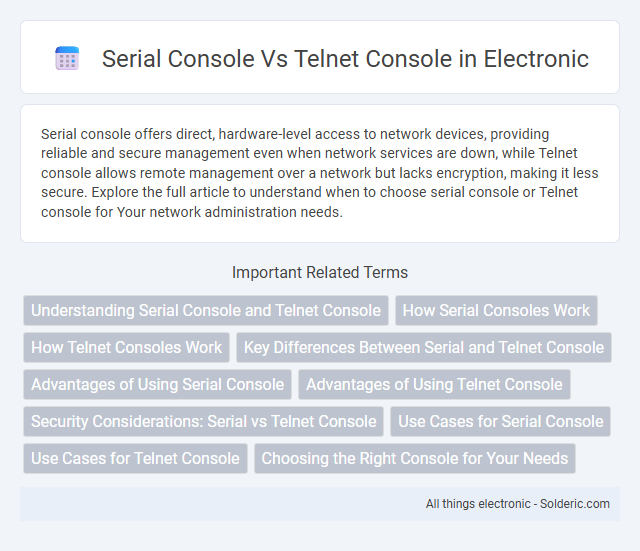Serial console offers direct, hardware-level access to network devices, providing reliable and secure management even when network services are down, while Telnet console allows remote management over a network but lacks encryption, making it less secure. Explore the full article to understand when to choose serial console or Telnet console for Your network administration needs.
Comparison Table
| Feature | Serial Console | Telnet Console |
|---|---|---|
| Connection Type | Wired, via serial interface (RS-232) | Network-based, via TCP/IP |
| Access Method | Direct physical connection to device | Remote access over IP network |
| Security | Secure due to no network exposure | Less secure; requires encryption (e.g., SSH recommended) |
| Use Case | Low-level device management and troubleshooting | Remote device administration |
| Speed | Generally slower (up to 115.2 kbps) | Faster, depends on network bandwidth |
| Reliability | High, unaffected by network failures | Dependent on network stability |
| Setup Complexity | Requires physical cable and direct access | Requires network configuration and access credentials |
| Protocol | RS-232 standard serial signaling | Telnet protocol over TCP/IP |
Understanding Serial Console and Telnet Console
Serial console provides direct, physical access to a device through a serial port, enabling low-level management and troubleshooting without network dependency. Telnet console allows remote access to a device's command line interface over a network using the Telnet protocol but is less secure due to lack of encryption. Understanding these consoles is crucial for network administrators to choose between secure, local management with Serial console and remote management with Telnet console, especially in IT infrastructure environments.
How Serial Consoles Work
Serial consoles operate by establishing a direct, low-level communication link between a computer and its peripherals or network devices using serial ports (RS-232 or similar). Data transmitters send signals bit-by-bit over a serial cable, allowing administrators to monitor and configure devices even when network connectivity is unavailable. This method ensures reliable out-of-band management by providing access to system logs and BIOS-level settings through terminal emulation software.
How Telnet Consoles Work
Telnet consoles operate by establishing a network connection using the Telnet protocol over TCP/IP, allowing remote access to a device's command-line interface via a virtual terminal. This method transmits data in plain text, enabling users to interact with system consoles remotely for configuration and management tasks. Due to the lack of encryption, Telnet consoles are often replaced by more secure protocols like SSH in modern network environments.
Key Differences Between Serial and Telnet Console
Serial consoles provide direct, physical access to a device through a serial port, enabling low-level configuration and troubleshooting without relying on network connectivity. Telnet consoles operate over IP networks, allowing remote access to a device's command-line interface via TCP/IP protocols but with less security and potential latency issues compared to serial connections. Key differences include the need for physical proximity in serial consoles versus remote accessibility in Telnet consoles, along with variations in security, setup complexity, and network dependency.
Advantages of Using Serial Console
Serial console offers direct hardware-level access, ensuring reliable and secure management even when network services are down or unconfigured. It provides low latency communication, essential for troubleshooting boot issues and system crashes, without relying on network connectivity. Your ability to maintain control during critical failures enhances system stability and reduces downtime significantly.
Advantages of Using Telnet Console
Telnet console offers the advantage of remote access, allowing you to manage network devices without physical presence, which significantly enhances operational efficiency. Unlike serial consoles that require direct cabling and proximity, Telnet enables multiple simultaneous sessions over TCP/IP networks, boosting multitasking and real-time troubleshooting capabilities. Its compatibility with various platforms and support for encrypted connections further strengthens security and flexibility in remote device management.
Security Considerations: Serial vs Telnet Console
Serial consoles provide a direct physical connection to network devices, significantly reducing the risk of remote interception and unauthorized access compared to Telnet consoles, which transmit data in plaintext over IP networks. Telnet consoles are vulnerable to eavesdropping, session hijacking, and man-in-the-middle attacks due to the lack of encryption, making them less secure for remote management. Secure alternatives like SSH are generally recommended over Telnet, while serial consoles remain a secure option primarily for local device access.
Use Cases for Serial Console
Serial consoles are essential for troubleshooting network devices and servers during system boot or hardware failures when remote access is unavailable. They provide direct, low-level access to a device's command line interface, making them ideal for configuring BIOS settings or recovering from critical errors. You rely on serial consoles for secure, out-of-band management in data centers and environments where network connectivity is unreliable or disabled.
Use Cases for Telnet Console
Telnet console is primarily used for remote management and configuration of network devices such as routers, switches, and firewalls, enabling administrators to access systems over IP networks without physical presence. This console method supports troubleshooting and performing routine maintenance tasks from any location with network connectivity, increasing operational flexibility. It is suitable for environments requiring quick, remote access to multiple devices, especially in geographically dispersed infrastructures.
Choosing the Right Console for Your Needs
Choosing the right console depends on your connectivity and security requirements. Serial consoles offer direct, low-level access to hardware with minimal latency, ideal for initial configuration and troubleshooting when network access is unavailable. Telnet consoles provide remote access over IP networks but pose security risks due to unencrypted data, making them suitable only in trusted environments or replaced by secure protocols like SSH for safer remote management.
Serial console vs Telnet console Infographic

 solderic.com
solderic.com